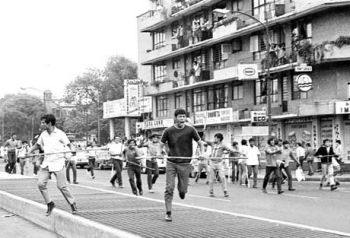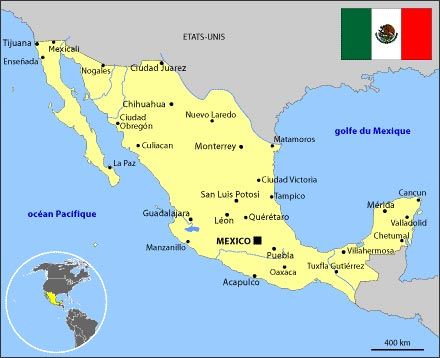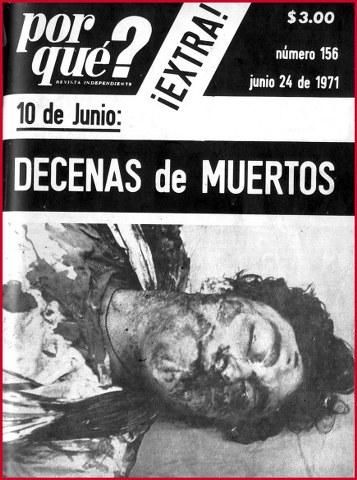
Publisher:
Bonnie King
CONTACT:
Newsroom@Salem-news.com
Advertising:
Adsales@Salem-news.com

~Truth~
~Justice~
~Peace~
TJP
Jun-06-2011 00:17


 TweetFollow @OregonNews
TweetFollow @OregonNews
Ciudad Juarez: The Long (and Bloody) Road to June 10
Salem-News.comA trip back in history reveals a trajectory that leads straight to Ciudad Juarez.
 10 June 1071 in Mexico City. Courtesy: jornada.unam.mx |
(CIUDAD JUAREZ, Mexico) - On June 10, hundreds if not thousands of people from Mexican non-governmental organizations are expected to gather in Ciudad Juarez to sign a pact that organizers say is the first step in bringing a halt to the so-called drug war and putting Mexico on a new road to peace, justice and democracy.
“Paradoxically, Ciudad Juarez, this city broken by institutional abandonment, by a neo-liberal economic policy and by the disdain of the government for decades, could be the hopeful beginning of this citizen movement that is so needed at the national level in order to provoke change, to initiate a new stage in the life of the country,” wrote Proceso columnist Jose Gil Olmos.
In truth, no one can say with any certainty what will come of the movement inspired by poet Javier Sicilia, who transformed the murder of his son in the state of Morelos last March, into a national crusade for reform and national reconstruction that’s stirred the imagination of many Mexicans.
But a trip back in history reveals a trajectory that leads straight to Ciudad Juarez.
The date, June 10, is an important one in the Mexican memory. On June 10, 1971, a big squad of goons known as the halcones, trained and coordinated by the Mexican military, viciously attacked a pro-democracy march of 10,000 students in Mexico City, killing dozens and injuring many others.
The perpetrators of the Corpus Christ Massacre, or simply the halconazo as it is commonly referred to in Mexico, had been used by the Mexican government since the late 1960s to quash rising opposition to the one-party rule of the Institutional Revolutionary Party (PRI). Some of the halcones were sent to the US for training.
Guided by the anti-communism of the Cold War, Washington was quite aware of the Mexican government’s use of torture and killing to stamp out opposition, and collaborated with its junior partner to make sure any hints of “subversion” on the southern border were carefully monitored and taken care of in due time.
In essence, Washington’s Mexico policy was an extension of its domestic one. The early 1970s were the height of the COINTELPRO program against the Black liberation, Chicano, Native American and other movements. Among other tactics, COINTELPRO included illegal break-ins, wire-tapping, phony legal charges and the use of “snitch jackets” designed to disrupt and divide opposition forces.
A prime target of COINTELPRO, Vietnam veteran and Los Angeles Black Panther Party leader Geronimo Pratt spent 27 years in prison for a murder he did not commit. Pratt died in Tanzania last week at the age of 63.
National Security Archive researcher Kate Doyle, who has reviewed numerous US government documents related to Mexico, once contacted former US Ambassador Patrick J. Lucey, who served during the Carter years in the late 1970s.
Even in an era of official human rights policy, Washington’s interests in Mexico were trade, migration, oil and drugs, Lucey told Doyle. In short, the same priorities as now.
 |
 |
The halconazo stoked the wheels of armed resistance to the PRI government, which had been boiling ever since similar government-sponsored killings and massacres in Chihuahua, Guerrero and Mexico City in the 1960s.
In his landmark book on the Mexican intelligence services, La Charola, author Sergio Aguayo quotes the writings of Gustavo Hireles, a former leader of the guerrilla September 23rd Communist League.
In reference to the halconazo, Hireles wrote: “It hit the people like a bomb. It was the confirmation, if one was needed, that these ‘sons of bitches’ had no cure….”
In response to the guerrilla upsurge, Mexico City unleashed the Dirty War. Although the Dirty War extended across virtually the entire country, ground zero was in the state of Guerrero.
In the shadows of the then-trendy jet-set resort of Acapulco, armed opposition led by schoolteachers Genaro Vazquez and Lucio Cabanas garnered mass support. Hundreds of people were kidnapped never to be seen again, villages locked down or ransacked and entire families targeted for torture, interrogation and possible execution by government security forces.
Early on, Washington judged Cabanas’ movement “terrorist.” Today, many in Guerrero consider Vazquez and Cabanas fallen heroes; several years ago, the Guerrero State Congress, including members of the PRI against which Cabanas fought so fiercely, rendered a posthumous recognition to the slain guerrilla leader, whose bust now stands in the town plaza of Atoyac de Alvarez.
As COINTELRO raged away north of the border and the Dirty War south of it, the Nixon administration opened another front when it declared the war on drugs 40 years ago.
The Halconazo, the Guerrero scorched-earth campaign and other atrocities of the Dirty War were investigated by a special prosecutor appointed by the administration of President Vicente Fox. The stated goal was to hold officials accountable for human rights violations. But six years passed and no successful prosecutions resulted.
Unlike other Latin American countries, Mexico did not undergo an official historical reckoning with its recent past of repression and violence.
“Mexico still has no idea on how to pursue a legal process against the ones responsible for the Dirty War,” Doyle was quoted at a presentation in Guerrero last year.
With the guerrilla opposition temporarily quelled (an even bigger one arose in the 1990s), members of the security forces engaged in other pursuits.
For example, before it was disbanded in the 1980s, the Federal Security Directorate, Mexico’s equivalent of a combined FBI-CIA super-agency, was known to control the illegal drug trade. Time and again, current and former police and soldiers have popped up in the ranks of organized crime.
Meantime, the US trained thousands of new Mexican police and soldiers. A free trade agreement was signed with Mexico, many new US factories relocated south of the border, the national PRI government changed to the PAN government and a broadened, binational anti-drug campaign was agreed to between Washington and Mexico City in the form of the Merida Initiative, which promised yet more training of Mexican security forces, new military equipment and high-level collaboration.
Embraced by US employers, millions of impoverished Mexicans headed north to pick fruits and vegetables for busy US households, clean rooms for hurried US travelers and build new homes for anxious buyers ready to live the American Dream.

But when Mexicans suddenly became discardable in the post-2008 economy, hundreds of thousands of them were simply deported back home. And the country they came back to was arguably even in much worse shape than the one they had left to pursue their own version of the American Dream.
Commerce between the US and Mexico exploded, and not only in legal goods. Despite the “Just Say No” rhetoric of the Reagan years, millions and millions of Americans shot heroin into their veins, sniffed cocaine up their noses and blew pot smoke into the face of the law.
In a recent US speech, poet Sicilia laid bare the cross-border drug connection: “While in the US, people like Charlie Sheen or Paris Hilton glorify and promote the consumption of drugs in their shows and in the media, we are obliged to pursue the producers. While the US has a legal industry worse than drugs-the arms industry-that arms the forces of the Mexican state as well as those of organized crime, we provide the dead bodies, the suffering and the fear on a daily basis.
While North American banks and institutions collude with Mexican banks and institutions that launder money, we the citizens of Mexico live in misery and in terror.”
Contemporary media reports tend to frame the Mexican drug violence as if it began in 2006, with an estimated 40,000 people murdered and possibly as many as 10,000 forcibly disappeared just in the last five years. But the historical toll is far greater, if one goes back a few decades and includes other bouts of narco-violence as well as the political violence that preceded it as part of the bigger picture.
 |
In the long view, the murmurs of the disappeared and the ghosts of the dead from the Dirty War are almost audible and nearly visible in today’s mass graves of Tamaulipas, Durango and Coahuila.
To turn the tide, Javier Sicilia’s movement proposes six basic changes. They include an end to impunity and violence, an attack on the financial structures of organized crime, special attention to the needs of youth, participatory democracy and democratization of the mass media.
On June 10, the 40th anniversary of the halconazo, representatives of hundreds of non-governmental organizations plan to sign the six-point pact in Ciudad Juarez, the city where Benito Juarez found refuge from French invaders in the 1860s and the place where a strategic victory for rebels was scored in the 1910 Revolution.
The goal of the movement and its pact is to awaken civil society as a conscious agent of change and non-violently reassert the force of the citizenry in a political landscape dominated by organized political parties, shadowy syndicates and powerful business groups of different stripes.
It is unclear whether the pact will serve as the springboard for dialogue between the new movement and the powers-that-be. In a broad sense, however, the nascent movement is more akin to the civil uprisings that have rocked Egypt, Tunisia, Spain and even Madison, Wisconsin, this year.
The “June 10th Movement” of Javier Sicilia and his allies shares characteristics of what Latin American political analyst Raul Zibechi defines as revolts of the “common people” that side-step traditional political structures and establish “horizontal political relations, in self-controlled spaces, autonomous and sovereign in which nobody imposes and orders the collective.”
On Saturday, June 4, Sicilia and several hundred people left Cuernavaca, Morelos, on the Caravan for Peace with Justice and Dignity destined for Ciudad Juarez. Along the way, on a veritable tour of death and destruction, they plan stops in other cities devastated by the so-called drug war.
 |
They will likely hear many stories of pain, personal tragedy and unspeakable horror. But they will give out their call for a new republic, a society where violence and corruption are curbed, human rights respected, young people accorded the chance for a dignified future, and the “common people” given their voice in national affairs.
The caravan is finding common ground in the US, as the issues raised in the six-point pact are resonating in the US just as they are to Mexico. On the morning of June 11, the El Paso-based Peace and Justice without Borders plans an event featuring Sicilia in the downtown plaza of Texas border city.
In addition to supporting the six-point pact, activists demand that the US put into practice international humanitarian law and facilitate the stay of Mexicans fleeing violence and seeking political asylum.
“Certainly, today’s Mexico, so destroyed and so hurt does not allow hope,” Sicilia said in his recent US speech. Sicilia then spoke of a conversation between Napoleon and Fontanes, and the thoughts of Albert Camus, in offering an alternative option for the future.
“At the end of the day, a good rule of conduct is to think that the free spirit always has reason and always winds up triumphing,” Sicilia said, “because the day when reason disappears will be the day humanity as a whole stops having it and the history of mankind loses its sense.”
Sources:
- La Jornada, June 4, 2011. Articles by Alonso Urrutia and Raul Zibechi.
- Lapolaka.com, May 30 and June 3, 2011.
- El Diario de Juarez, June 3, 2011.
- Proceso/Apro, May 19, 25 and 31, 2011; June 1 and 3, 2011. Articles by Jose Gil Olmos and Arturo Rodriguez Garcia.
- Yourblackworld.com, June 3, 2011. Article by Dr. Boyce Watkins.
- El Sur, September 28. 2010. Article by Zacarias Cervantes.
- La Charola: una historia de los servicios de inteligencia en Mexico. Sergio Aguayo.
- Grijalbo, 2001. Www.gwu.edu/~nsarchiv/
Frontera NorteSur: on-line, U.S.-Mexico border news
Center for Latin American and Border Studies
New Mexico State University
Las Cruces, New Mexico
Articles for June 5, 2011 | Articles for June 6, 2011 | Articles for June 7, 2011

googlec507860f6901db00.html
Salem-News.com:



Terms of Service | Privacy Policy

All comments and messages are approved by people and self promotional links or unacceptable comments are denied.
malcolm kyle June 6, 2011 1:47 am (Pacific time)
If you are a Prohibitionist then you owe us answers to the following questions:
[Return to Top]#1. Why do you rejoice at the fact that we have all been stripped of our 4th amendment rights and are now totally subordinate to a corporatized, despotic government with a heavily armed and corrupt, militarized police force whose often deadly intrusions into our homes and lives are condoned by an equally corrupt and spineless judiciary?
#2. Why do you wish to continue to spend $50 billion a year to prosecute and cage your fellow citizens for choosing drugs which are not more dangerous than those of which you yourself use and approve of such as alcohol and tobacco?
#3. Do you honestly expect the rest of us to look on passively while you waste another trillion dollars on this garbage policy?
#4. Why are your waging war on your own family, friends and neighbors?
#5. Why are you so complacent with the fact that our once 'free and proud' nation now has the largest percentage of it's citizenry incarcerated than any other on the entire planet?
#6. Why are you helping to fuel a budget crisis to the point of closing hospitals, schools and libraries?
#7. Why do you rejoice at wasting precious resources on prohibition related undercover work while rapists and murderers walk free, while additionally, many cases involving murder and rape do not even get taken to trial because law enforcement priorities are subverted by your beloved failed and dangerous policy?
#8. Why are you such a supporter of the 'prison industrial complex' to the extent of endangering our own children?
#9. Will you graciously applaud, when due to your own incipient and authoritarian approach, even your own child is caged and raped?
* It is estimated that there are over 300,000 instances of prison rape a year. * 196,000 are estimated to happen to men in prison. * 123,000 are estimated to happen to men in county jail. * 40,000 are estimated to be committed against boys in either adult prisons or while in juvenile facilities or lock ups. * 5000 women are estimated to be raped in prison.
http://www.loompanics.com/Articles/RapeInPrison.html
#10. And will you also applaud when your own child, due to an unnecessary and counter productive felony conviction, can no longer find employment?
Private prisons are publicly traded and their stock value is tied to the number of inmates. Here's what the UK Economist Magazine thinks of the situation: "Never in the civilised world have so many been locked up for so little" http://www.economist.com/node/16636027
According to Paul Craig Roberts, a former editor of the Wall Street Journal and former assistant secretary to the treasury under Ronald Reagan, "Police in the US now rival criminals, and exceed terrorists as the greatest threat to the American public."
"Narcotics police are an enormous, corrupt international bureaucracy and now fund a coterie of researchers who provide them with ‘scientific support’, fanatics who distort the legitimate research of others. The anti-marijuana campaign is a cancerous tissue of lies, undermining law enforcement, aggravating the drug problem, depriving the sick of needed help, and suckering well-intentioned conservatives and countless frightened parents." – William F. Buckley, Commentary in The National Review, April 29, 1983, p. 495
There is no conflict between liberty and safety. We will have both or neither. William Ramsey Clark (1927--)
©2025 Salem-News.com. All opinions expressed in this article are those of the author and do not necessarily reflect those of Salem-News.com.